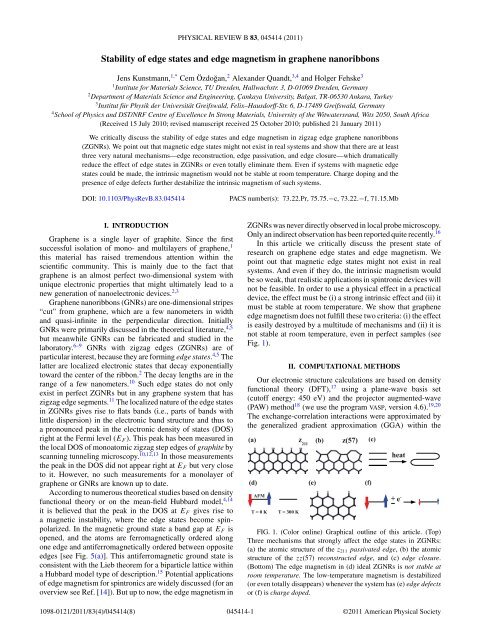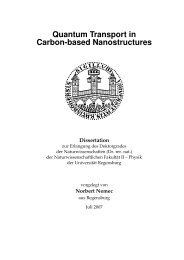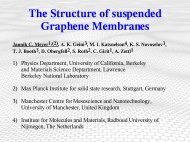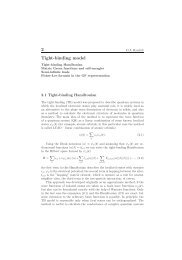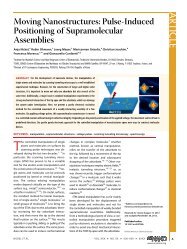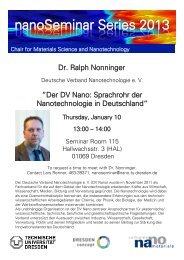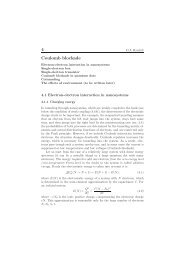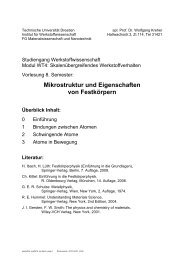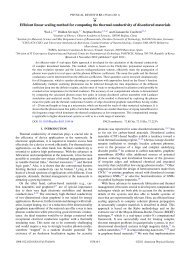Stability of edge states and edge magnetism in graphene nanoribbons
Stability of edge states and edge magnetism in graphene nanoribbons
Stability of edge states and edge magnetism in graphene nanoribbons
You also want an ePaper? Increase the reach of your titles
YUMPU automatically turns print PDFs into web optimized ePapers that Google loves.
PHYSICAL REVIEW B 83, 045414 (2011)<br />
<strong>Stability</strong> <strong>of</strong> <strong>edge</strong> <strong>states</strong> <strong>and</strong> <strong>edge</strong> <strong>magnetism</strong> <strong>in</strong> <strong>graphene</strong> <strong>nanoribbons</strong><br />
Jens Kunstmann, 1,* Cem Özdo˘gan, 2 Alex<strong>and</strong>er Qu<strong>and</strong>t, 3,4 <strong>and</strong> Holger Fehske 3<br />
1 Institute for Materials Science, TU Dresden, Hallwachstr. 3, D-01069 Dresden, Germany<br />
2 Department <strong>of</strong> Materials Science <strong>and</strong> Eng<strong>in</strong>eer<strong>in</strong>g, Çankaya University, Balgat, TR-06530 Ankara, Turkey<br />
3 Institut für Physik der Universität Greifswald, Felix–Hausdorff-Str. 6, D-17489 Greifswald, Germany<br />
4 School <strong>of</strong> Physics <strong>and</strong> DST/NRF Centre <strong>of</strong> Excellence In Strong Materials, University <strong>of</strong> the Witwatersr<strong>and</strong>, Wits 2050, South Africa<br />
(Received 15 July 2010; revised manuscript received 25 October 2010; published 21 January 2011)<br />
We critically discuss the stability <strong>of</strong> <strong>edge</strong> <strong>states</strong> <strong>and</strong> <strong>edge</strong> <strong>magnetism</strong> <strong>in</strong> zigzag <strong>edge</strong> <strong>graphene</strong> <strong>nanoribbons</strong><br />
(ZGNRs). We po<strong>in</strong>t out that magnetic <strong>edge</strong> <strong>states</strong> might not exist <strong>in</strong> real systems <strong>and</strong> show that there are at least<br />
three very natural mechanisms—<strong>edge</strong> reconstruction, <strong>edge</strong> passivation, <strong>and</strong> <strong>edge</strong> closure—which dramatically<br />
reduce the effect <strong>of</strong> <strong>edge</strong> <strong>states</strong> <strong>in</strong> ZGNRs or even totally elim<strong>in</strong>ate them. Even if systems with magnetic <strong>edge</strong><br />
<strong>states</strong> could be made, the <strong>in</strong>tr<strong>in</strong>sic <strong>magnetism</strong> would not be stable at room temperature. Charge dop<strong>in</strong>g <strong>and</strong> the<br />
presence <strong>of</strong> <strong>edge</strong> defects further destabilize the <strong>in</strong>tr<strong>in</strong>sic <strong>magnetism</strong> <strong>of</strong> such systems.<br />
DOI: 10.1103/PhysRevB.83.045414 PACS number(s): 73.22.Pr, 75.75.−c, 73.22.−f, 71.15.Mb<br />
I. INTRODUCTION<br />
Graphene is a s<strong>in</strong>gle layer <strong>of</strong> graphite. S<strong>in</strong>ce the first<br />
successful isolation <strong>of</strong> mono- <strong>and</strong> multilayers <strong>of</strong> <strong>graphene</strong>, 1<br />
this material has raised tremendous attention with<strong>in</strong> the<br />
scientific community. This is ma<strong>in</strong>ly due to the fact that<br />
<strong>graphene</strong> is an almost perfect two-dimensional system with<br />
unique electronic properties that might ultimately lead to a<br />
new generation <strong>of</strong> nanoelectronic devices. 2,3<br />
Graphene <strong>nanoribbons</strong> (GNRs) are one-dimensional stripes<br />
“cut” from <strong>graphene</strong>, which are a few nanometers <strong>in</strong> width<br />
<strong>and</strong> quasi-<strong>in</strong>f<strong>in</strong>ite <strong>in</strong> the perpendicular direction. Initially<br />
GNRs were primarily discussed <strong>in</strong> the theoretical literature, 4,5<br />
but meanwhile GNRs can be fabricated <strong>and</strong> studied <strong>in</strong> the<br />
laboratory. 6–9 GNRs with zigzag <strong>edge</strong>s (ZGNRs) are <strong>of</strong><br />
particular <strong>in</strong>terest, because they are form<strong>in</strong>g <strong>edge</strong> <strong>states</strong>. 4,5 The<br />
latter are localized electronic <strong>states</strong> that decay exponentially<br />
toward the center <strong>of</strong> the ribbon. 2 The decay lengths are <strong>in</strong> the<br />
range <strong>of</strong> a few nanometers. 10 Such <strong>edge</strong> <strong>states</strong> do not only<br />
exist <strong>in</strong> perfect ZGNRs but <strong>in</strong> any <strong>graphene</strong> system that has<br />
zigzag <strong>edge</strong> segments. 11 The localized nature <strong>of</strong> the <strong>edge</strong> <strong>states</strong><br />
<strong>in</strong> ZGNRs gives rise to flats b<strong>and</strong>s (i.e., parts <strong>of</strong> b<strong>and</strong>s with<br />
little dispersion) <strong>in</strong> the electronic b<strong>and</strong> structure <strong>and</strong> thus to<br />
a pronounced peak <strong>in</strong> the electronic density <strong>of</strong> <strong>states</strong> (DOS)<br />
right at the Fermi level (EF ). This peak has been measured <strong>in</strong><br />
the local DOS <strong>of</strong> monoatomic zigzag step <strong>edge</strong>s <strong>of</strong> graphite by<br />
scann<strong>in</strong>g tunnel<strong>in</strong>g microscopy. 10,12,13 In those measurements<br />
the peak <strong>in</strong> the DOS did not appear right at EF but very close<br />
to it. However, no such measurements for a monolayer <strong>of</strong><br />
<strong>graphene</strong> or GNRs are known up to date.<br />
Accord<strong>in</strong>g to numerous theoretical studies based on density<br />
functional theory or on the mean-field Hubbard model, 4,14<br />
it is believed that the peak <strong>in</strong> the DOS at EF gives rise to<br />
a magnetic <strong>in</strong>stability, where the <strong>edge</strong> <strong>states</strong> become sp<strong>in</strong>polarized.<br />
In the magnetic ground state a b<strong>and</strong> gap at EF is<br />
opened, <strong>and</strong> the atoms are ferromagnetically ordered along<br />
one <strong>edge</strong> <strong>and</strong> antiferromagnetically ordered between opposite<br />
<strong>edge</strong>s [see Fig. 5(a)]. This antiferromagnetic ground state is<br />
consistent with the Lieb theorem for a biparticle lattice with<strong>in</strong><br />
a Hubbard model type <strong>of</strong> description. 15 Potential applications<br />
<strong>of</strong> <strong>edge</strong> <strong>magnetism</strong> for sp<strong>in</strong>tronics are widely discussed (for an<br />
overview see Ref. [14]). But up to now, the <strong>edge</strong> <strong>magnetism</strong> <strong>in</strong><br />
ZGNRs was never directly observed <strong>in</strong> local probe microscopy.<br />
Only an <strong>in</strong>direct observation has been reported quite recently. 16<br />
In this article we critically discuss the present state <strong>of</strong><br />
research on <strong>graphene</strong> <strong>edge</strong> <strong>states</strong> <strong>and</strong> <strong>edge</strong> <strong>magnetism</strong>. We<br />
po<strong>in</strong>t out that magnetic <strong>edge</strong> <strong>states</strong> might not exist <strong>in</strong> real<br />
systems. And even if they do, the <strong>in</strong>tr<strong>in</strong>sic <strong>magnetism</strong> would<br />
be so weak, that realistic applications <strong>in</strong> sp<strong>in</strong>tronic devices will<br />
not be feasible. In order to use a physical effect <strong>in</strong> a practical<br />
device, the effect must be (i) a strong <strong>in</strong>tr<strong>in</strong>sic effect <strong>and</strong> (ii) it<br />
must be stable at room temperature. We show that <strong>graphene</strong><br />
<strong>edge</strong> <strong>magnetism</strong> does not fulfill these two criteria: (i) the effect<br />
is easily destroyed by a multitude <strong>of</strong> mechanisms <strong>and</strong> (ii) it is<br />
not stable at room temperature, even <strong>in</strong> perfect samples (see<br />
Fig. 1).<br />
II. COMPUTATIONAL METHODS<br />
Our electronic structure calculations are based on density<br />
functional theory (DFT), 17 us<strong>in</strong>g a plane-wave basis set<br />
(cut<strong>of</strong>f energy: 450 eV) <strong>and</strong> the projector augmented-wave<br />
(PAW) method 18 (we use the program VASP, version 4.6). 19,20<br />
The exchange-correlation <strong>in</strong>teractions were approximated by<br />
the generalized gradient approximation (GGA) with<strong>in</strong> the<br />
FIG. 1. (Color onl<strong>in</strong>e) Graphical outl<strong>in</strong>e <strong>of</strong> this article. (Top)<br />
Three mechanisms that strongly affect the <strong>edge</strong> <strong>states</strong> <strong>in</strong> ZGNRs:<br />
(a) the atomic structure <strong>of</strong> the z211 passivated <strong>edge</strong>, (b) the atomic<br />
structure <strong>of</strong> the zz(57) reconstructed <strong>edge</strong>, <strong>and</strong>(c)<strong>edge</strong> closure.<br />
(Bottom) The <strong>edge</strong> <strong>magnetism</strong> <strong>in</strong> (d) ideal ZGNRs is not stable at<br />
room temperature. The low-temperature <strong>magnetism</strong> is destabilized<br />
(or even totally disappears) whenever the system has (e) <strong>edge</strong> defects<br />
or (f) is charge doped.<br />
1098-0121/2011/83(4)/045414(8) 045414-1<br />
©2011 American Physical Society
KUNSTMANN, ÖZDO ˘GAN, QUANDT, AND FEHSKE PHYSICAL REVIEW B 83, 045414 (2011)<br />
FIG. 2. (Color onl<strong>in</strong>e) Atomic structures (top) <strong>and</strong> nonmagnetic<br />
b<strong>and</strong> structures (bottom) <strong>of</strong> a 12-ZGNR with (a) unpassivated<br />
<strong>edge</strong>s <strong>and</strong> (b) monohydrogenated <strong>edge</strong>s. The fatness <strong>of</strong> the b<strong>and</strong>s<br />
is proportional to the orbital character <strong>of</strong> the correspond<strong>in</strong>g wave<br />
function on the encircled <strong>edge</strong> atom (top). Orange (light gray)<br />
represents the π character <strong>of</strong> the b<strong>and</strong>s, <strong>and</strong> blue (dark gray)<br />
represents their σ character. Gray horizontal l<strong>in</strong>es were added to<br />
the atomic structure (top) <strong>in</strong> order to <strong>in</strong>dicate the boundaries <strong>of</strong><br />
the correspond<strong>in</strong>g unit cell along the periodic direction (see also<br />
Fig. 5). Because <strong>of</strong> the presence <strong>of</strong> (partially) flat b<strong>and</strong>s near EF <strong>in</strong><br />
the nonmagnetic b<strong>and</strong> structure, there will be a magnetic transition<br />
<strong>in</strong>to an antiferromagnetic ground state with a b<strong>and</strong> gap (not shown).<br />
Perdew-Wang parametrization (PW91). 21 Total energies <strong>in</strong><br />
the self-consistency cycle were converged such that energetic<br />
changes were less than 10 −4 eV. The k-space <strong>in</strong>tegrations were<br />
carried out us<strong>in</strong>g the method <strong>of</strong> Methfessel <strong>and</strong> Paxton 22 <strong>in</strong><br />
first order, with a smear<strong>in</strong>g width <strong>of</strong> 0.1 eV for the structural<br />
optimizations <strong>and</strong> with the improved tetrahedron method 23 for<br />
a f<strong>in</strong>al static calculation <strong>of</strong> the total energies. The optimal sizes<br />
<strong>of</strong> the k-po<strong>in</strong>t meshes for different systems were <strong>in</strong>dividually<br />
converged, such that changes <strong>in</strong> the total energy were reduced<br />
to at least 3 meV/atom. 24<br />
In our study we consider 10-ZGNRs <strong>and</strong> 12-ZGNRs, where<br />
the prefix “10” or “12” represents the number <strong>of</strong> zigzag l<strong>in</strong>es<br />
across the width <strong>of</strong> the ribbon. A suffix “+H” <strong>in</strong>dicates that<br />
each carbon <strong>edge</strong> atom is passivated by one hydrogen atom,<br />
“+EV” that one <strong>edge</strong> conta<strong>in</strong>s an <strong>edge</strong> vacancy, “+zz(57)” that<br />
the <strong>edge</strong> is reconstructed with alternat<strong>in</strong>g l<strong>in</strong>es <strong>of</strong> pentagons<br />
<strong>and</strong> heptagons, <strong>and</strong> “+z211” that one out <strong>of</strong> three <strong>edge</strong> atoms<br />
is passivated by two hydrogen atoms <strong>and</strong> the other two by one<br />
hydrogen atom. The atomic structures <strong>of</strong> some <strong>of</strong> these systems<br />
are shown <strong>in</strong> Figs. 2–5. For the calculations <strong>of</strong> a H2 molecule,<br />
<strong>graphene</strong>, <strong>and</strong> the ZGNRs, we simulate free-st<strong>and</strong><strong>in</strong>g objects,<br />
where the vacuum region between replica <strong>in</strong> neighbor<strong>in</strong>g unit<br />
cells is at least 10 ˚A wide. 25<br />
In Table I we list the <strong>edge</strong> energies <strong>of</strong> all ZGNRs that<br />
are considered <strong>in</strong> this study. The <strong>edge</strong> energy quantifies the<br />
045414-2<br />
FIG. 3. (Color onl<strong>in</strong>e) Atomic structures <strong>and</strong> b<strong>and</strong> structures <strong>of</strong><br />
a 12-ZGNR with a zz(57) <strong>edge</strong> reconstruction for (a) unpassivated<br />
<strong>edge</strong>s <strong>and</strong> (b) monohydrogenated <strong>edge</strong>s (see Fig. 2). The system is<br />
metallic <strong>and</strong> nonmagnetic <strong>and</strong> has <strong>edge</strong> <strong>states</strong>.<br />
energy needed to form an <strong>edge</strong> from <strong>in</strong>f<strong>in</strong>ite <strong>graphene</strong> <strong>and</strong><br />
(for hydrogen-passivated systems) molecular hydrogen, i.e.,<br />
the enthalpy <strong>of</strong> the virtual reaction<br />
<strong>graphene</strong> + NH/2H2 −→ ZGNR.<br />
FIG. 4. (Color onl<strong>in</strong>e) Atomic structure <strong>and</strong> b<strong>and</strong> structure <strong>of</strong> a<br />
12-ZGNR with a z211 <strong>edge</strong> (see Fig. 2). The system does not have<br />
<strong>edge</strong> <strong>states</strong>, it is nonmagnetic, <strong>and</strong> a semiconductor. Its b<strong>and</strong> gap is<br />
0.61 eV.
STABILITY OF EDGE STATES AND EDGE MAGNETISM ... PHYSICAL REVIEW B 83, 045414 (2011)<br />
TABLE I. Edge energies Eat <strong>edge</strong> <strong>and</strong> Elen <strong>edge</strong> as def<strong>in</strong>ed by Eqs. (1)<br />
<strong>and</strong> (2), as well as hydrogen adsorption energies EH ads as def<strong>in</strong>ed by<br />
Eq. (3), both calculated at the DFT/GGA/PAW level <strong>of</strong> theory.<br />
System Eat <strong>edge</strong> (eV/at) Elen <strong>edge</strong> (eV/ ˚A) EH ads (eV/at)<br />
10-ZGNR 2.99 1.21 –<br />
10-ZGNR+H 0.26 0.11 −2.73<br />
12-ZGNR 3.00 1.21 –<br />
12-ZGNR+H 0.28 0.11 −2.72<br />
12-ZGNR+z211 0.08 0.03 −2.91<br />
12-ZGNR+zz(57) 2.39 0.97 –<br />
12-ZGNR+zz(57)+H 0.87 0.36 −1.52<br />
10-ZGNR+EV 2.88 1.17 –<br />
10-ZGNR+EV+H 0.86 0.35 −2.02<br />
The <strong>edge</strong> energy can be def<strong>in</strong>ed per <strong>edge</strong> atom (Eat <strong>edge</strong> ) or per<br />
unit length along the <strong>edge</strong> (Elen <strong>edge</strong> ) as follows:<br />
E at<br />
<strong>edge</strong> = E ZGNR <strong>graphene</strong><br />
tot − NCEcoh − NHE H2<br />
<strong>edge</strong><br />
coh NC (1)<br />
E len<br />
<strong>edge</strong> = E ZGNR <strong>graphene</strong><br />
tot − NCEcoh − NHE H2<br />
<br />
coh 2A, (2)<br />
where NC, NH, <strong>and</strong> N <strong>edge</strong><br />
C are the number <strong>of</strong> carbon, hydrogen,<br />
<strong>and</strong> carbon <strong>edge</strong> atoms per unit cell, respectively.<br />
EZGNR tot is the total energy per unit cell <strong>of</strong> the ZGNRs<br />
<strong>in</strong> the (magnetic) ground state as given <strong>in</strong> Table II, <strong>and</strong><br />
E <strong>graphene</strong><br />
coh =−9.244 eV/atom <strong>and</strong> E H2<br />
coh =−3.394 eV/atom<br />
are the cohesive energies <strong>of</strong> a carbon atom <strong>in</strong> <strong>graphene</strong> <strong>and</strong> a<br />
hydrogen atom <strong>in</strong> the H2 molecule, respectively. A is the lattice<br />
constant <strong>in</strong> the periodic direction, as <strong>in</strong>dicated <strong>in</strong> Fig. 5(b).<br />
Note that <strong>in</strong> Eq. (2) we divided by 2A, because the unit cell<br />
conta<strong>in</strong>s both <strong>edge</strong>s <strong>of</strong> the ZGNR. Our results for <strong>edge</strong> energies<br />
compare well with previous data for such systems. 26,27<br />
The hydrogen adsorption energies <strong>in</strong> Table I quantify the<br />
ga<strong>in</strong> <strong>in</strong> energy <strong>of</strong> a hydrogen-passivated ZGNR, as compared<br />
to an unpassivated system <strong>and</strong> molecular hydrogen. In other<br />
words, it is the enthalpy <strong>of</strong> the reaction<br />
ZGNR + NH/2H2 −→ ZGNR+H.<br />
The hydrogen adsorption energy per carbon <strong>edge</strong> atom is<br />
def<strong>in</strong>ed as<br />
E H ads = E ZGNR+H<br />
tot − E ZGNR H2 <strong>edge</strong><br />
tot − NHEcoh NC , (3)<br />
where E ZGNR+H<br />
tot <strong>and</strong> EZGNR tot are the total energies <strong>of</strong><br />
the hydrogen-passivated <strong>and</strong> the nonpassivated ZGNR,<br />
respectively.<br />
For magnetic systems we performed coll<strong>in</strong>ear, sp<strong>in</strong>polarized<br />
DFT calculations. The results are listed <strong>in</strong> Table II,<br />
compris<strong>in</strong>g energies <strong>and</strong> magnetic moments for nonmagnetic<br />
(NM), ferromagnetic (FM), <strong>and</strong> antiferromagnetic (AFM)<br />
<strong>states</strong>. The energies <strong>of</strong> different magnetic <strong>states</strong> are compared<br />
via the quantity Emag, that is, the difference <strong>in</strong> total energy<br />
with respect to the magnetic ground state (EGS) per magnetic<br />
atom:<br />
Emag = Etot − E GS<br />
tot NMA, (4)<br />
tot<br />
045414-3<br />
where NMA is the number <strong>of</strong> magnetic atoms per unit cell. For<br />
ZGNRs NMA is the number <strong>of</strong> magnetic carbon <strong>edge</strong> atoms<br />
per unit cell.<br />
III. DISCUSSION<br />
A. <strong>Stability</strong> <strong>of</strong> <strong>edge</strong> <strong>states</strong><br />
In a planar sp2 system like <strong>graphene</strong>, the electronic <strong>states</strong><br />
split <strong>in</strong>to <strong>in</strong>-plane (σ ) <strong>and</strong> out-<strong>of</strong>-plane (π) <strong>states</strong> that are<br />
decoupled by symmetry. At an unpassivated zigzag <strong>edge</strong> the<br />
hexagonal carbon network is <strong>in</strong>terrupted, <strong>and</strong> both the σ<br />
<strong>and</strong> the π system form <strong>edge</strong> <strong>states</strong>. The <strong>edge</strong> <strong>states</strong> <strong>of</strong> the<br />
σ system are unpaired electrons <strong>in</strong> sp2 orbitals, i.e., dangl<strong>in</strong>g<br />
σ bonds. The <strong>edge</strong> <strong>states</strong> <strong>of</strong> the π system are the ones that<br />
were <strong>in</strong>troduced above, <strong>and</strong> those are usually discussed <strong>in</strong> the<br />
literature. With<strong>in</strong> the nonmagnetic, electronic b<strong>and</strong> structure<br />
<strong>of</strong> an unpassivated ZGNR both sets <strong>of</strong> <strong>edge</strong> <strong>states</strong> appear as<br />
nearly flat b<strong>and</strong>s (or as flat parts <strong>of</strong> b<strong>and</strong>s) at EF . 26,28 These<br />
b<strong>and</strong>s are highlighted <strong>in</strong> Figs. 2–4. In all <strong>of</strong> these plots, the<br />
fatness <strong>of</strong> the b<strong>and</strong>s is proportional to the orbital character<br />
<strong>of</strong> the correspond<strong>in</strong>g wave function at an <strong>edge</strong> atom. Orange<br />
(light gray) represents their π character, <strong>and</strong> blue (dark gray)<br />
represents their σ character. The nonmagnetic b<strong>and</strong> structure<br />
<strong>of</strong> an unpassivated 12-ZGNR is shown <strong>in</strong> Fig. 2(a). Here the<br />
σ <strong>and</strong> π <strong>edge</strong> <strong>states</strong> exist <strong>in</strong> a range <strong>of</strong> about 0.5 eV above<br />
<strong>and</strong> below EF . Only the degenerate part <strong>of</strong> the π b<strong>and</strong> has<br />
<strong>edge</strong> state character, <strong>and</strong> its nondegenerate part has bulk state<br />
character. Flat b<strong>and</strong>s lead to a high DOS. As the chemical<br />
reactivity is proportional to the DOS near EF , an unpassivated<br />
ZGNR would be highly reactive, s<strong>in</strong>ce the <strong>edge</strong> <strong>states</strong> are<br />
available to form chemical bonds. In other words, the <strong>edge</strong><br />
<strong>states</strong> do not only lead to a magnetic <strong>in</strong>stability, but they also<br />
lead to a chemical <strong>and</strong> structural <strong>in</strong>stability. The latter will be<br />
discussed below. For the 12-ZGNR the magnetic <strong>in</strong>stability<br />
leads to an AFM ground state with a b<strong>and</strong> gap <strong>of</strong> 0.7 eV<br />
[Fig. 2(a) shows the b<strong>and</strong> structure <strong>of</strong> the metastable NM state].<br />
The high <strong>in</strong>stability <strong>of</strong> an unpassivated <strong>edge</strong> is marked by a<br />
rather high <strong>edge</strong> energy Elen <strong>edge</strong> <strong>of</strong> the 10-ZGNR <strong>and</strong> 12-ZGNR<br />
systems <strong>of</strong> 1.21 eV/ ˚A (see Table I).<br />
1. Edge passivation<br />
One stabilization mechanism for an unpassivated ZGNR is<br />
<strong>edge</strong> passivation. The system will catch any bond partner it<br />
can possibly get to saturate its dangl<strong>in</strong>g bonds. The majority<br />
<strong>of</strong> articles on ZGNRs consider monohydrogenated <strong>edge</strong>s with<br />
a s<strong>in</strong>gle hydrogen atom per <strong>edge</strong> atom. In these systems the<br />
dangl<strong>in</strong>g σ bonds are saturated, <strong>and</strong> the σ <strong>edge</strong> <strong>states</strong> are<br />
removed from the vic<strong>in</strong>ity <strong>of</strong> EF [see Fig. 2(b)]. However,<br />
the π <strong>edge</strong> <strong>states</strong> persist <strong>and</strong> render the system magnetic,<br />
which results <strong>in</strong> an AFM ground state discussed above (the<br />
b<strong>and</strong> structure <strong>of</strong> the AFM state is not shown). For the<br />
10-ZGNR <strong>and</strong> 12-ZGNR the <strong>edge</strong> energy drops from<br />
1.21 eV/ ˚A to0.11eV/ ˚A after passivation, which stabilizes<br />
these systems rather significantly.<br />
However, this type <strong>of</strong> <strong>edge</strong> passivation does not correspond<br />
to the thermodynamic ground state, as shown by Wassmann<br />
et al. on the basis <strong>of</strong> DFT/GGA calculations. 27 Accord<strong>in</strong>g to<br />
these authors the monohydrogenated zigzag <strong>edge</strong> (labeled z1<br />
<strong>in</strong> their article), as well as the zz(57) <strong>edge</strong>s discussed below,
KUNSTMANN, ÖZDO ˘GAN, QUANDT, AND FEHSKE PHYSICAL REVIEW B 83, 045414 (2011)<br />
are stable only at extremely low hydrogen concentrations<br />
(P 10 −20 bar at room temperature). At realistic hydrogen<br />
pressures, the only stable zigzag <strong>edge</strong> should be the z211<br />
state shown <strong>in</strong> Fig. 4, with two monohydrogenated sites <strong>and</strong><br />
one dihydrogenated site. Our calculation on a 12-ZGNR with<br />
the z211 <strong>edge</strong> confirm these f<strong>in</strong>d<strong>in</strong>gs, as the correspond<strong>in</strong>g <strong>edge</strong><br />
energy is only 0.03 eV/ ˚A, i.e., more than a factor <strong>of</strong> 3 lower<br />
than the monohydrogenated <strong>edge</strong>s. The result<strong>in</strong>g system does<br />
not have any <strong>edge</strong> <strong>states</strong>. It is a semiconductor with a b<strong>and</strong> gap<br />
<strong>of</strong> 0.61 eV, <strong>and</strong> it is nonmagnetic (see Fig. 4). The z211 <strong>edge</strong> is<br />
by far the most stable zigzag <strong>edge</strong> that is known up to now.<br />
For the z211 passivation type the dihydrogenated <strong>edge</strong> atoms<br />
are sp 3 hybridized. Therefore a departure from the regular sp 2<br />
structure at the <strong>edge</strong> will be a perfect way to get rid <strong>of</strong> the<br />
<strong>edge</strong> <strong>states</strong>, thus remov<strong>in</strong>g the peak with<strong>in</strong> the DOS at EF <strong>and</strong><br />
stabiliz<strong>in</strong>g the overall structure.<br />
2. Edge reconstruction<br />
Another stabilization mechanism for an unpassivated<br />
ZGNR is a structural deformation via <strong>edge</strong> reconstruction. In<br />
their DFT/GGA calculations Kosk<strong>in</strong>en et al. show that a planar<br />
reconstruction with alternat<strong>in</strong>g pentagon-heptagon carbon<br />
r<strong>in</strong>gs along the <strong>edge</strong>, named zz(57) (see Fig. 3), is 0.35 eV/ ˚A<br />
lower <strong>in</strong> <strong>edge</strong> energy than the normal zigzag <strong>edge</strong>. 26 In our own<br />
calculations <strong>of</strong> a 12-ZGNR+zz(57) system we found that the<br />
reconstructed <strong>edge</strong> is 0.24 eV/ ˚A lower <strong>in</strong> <strong>edge</strong> energy than the<br />
12-ZGNR system (see Table I). Compared to the <strong>edge</strong> energies<br />
<strong>of</strong> the hydrogen passivated systems this is only a modest<br />
lower<strong>in</strong>g, <strong>in</strong>dicat<strong>in</strong>g that the zz(57) <strong>edge</strong> reconstruction is<br />
likely to occur only <strong>in</strong> high vacuum.<br />
The Kosk<strong>in</strong>en reconstruction leads to the formation <strong>of</strong> triple<br />
bonds <strong>in</strong> the nearly l<strong>in</strong>ear parts <strong>of</strong> the heptagons, which shift the<br />
σ <strong>edge</strong> <strong>states</strong> away from EF [see Fig. 3(a)]. The π <strong>edge</strong> <strong>states</strong><br />
rema<strong>in</strong> near EF <strong>in</strong> two normally dispersed b<strong>and</strong>s that render<br />
the system metallic. However, there is no magnetic transition,<br />
because these b<strong>and</strong>s are not flat. We confirmed this fact on the<br />
basis <strong>of</strong> sp<strong>in</strong>-polarized calculations, which all converged <strong>in</strong>to a<br />
NM state. Aga<strong>in</strong>, only the degenerate part <strong>of</strong> the b<strong>and</strong> at EF can<br />
be associated with <strong>edge</strong> <strong>states</strong>; the nondegenerate part has bulk<br />
character. In the hydrogen passivated 12-ZGNR+zz(57)+H<br />
the σ <strong>edge</strong> <strong>states</strong> are removed from the b<strong>and</strong> structure, <strong>and</strong> the<br />
occupied π b<strong>and</strong>s are practically unchanged [see Fig. 3(b)].<br />
Because <strong>of</strong> the absence <strong>of</strong> σ <strong>states</strong> near EF , Kosk<strong>in</strong>en<br />
et al. argue that zz(57) reconstructed <strong>edge</strong>s do not need to<br />
be stabilized by passivation. They further show that such<br />
systems do not favor hydrogen passivation, <strong>and</strong> therefore they<br />
call the zz(57) reconstruction “self-passivat<strong>in</strong>g.” Our results<br />
support this judgment only partially. First, the <strong>edge</strong> energy <strong>of</strong><br />
0.97 eV/ ˚A for the unpassivated 12-ZGNR+zz(57) is still very<br />
high. And, second, we f<strong>in</strong>d that the hydrogen adsorption energy<br />
is −1.52 eV per <strong>edge</strong> atom. Here a negative sign <strong>in</strong>dicates<br />
that hydrogenation leads to an <strong>in</strong>crease <strong>of</strong> b<strong>in</strong>d<strong>in</strong>g energy,<br />
i.e., that hydrogen adsorption is favored. After passivation the<br />
<strong>edge</strong> energy <strong>of</strong> the system [12-ZGNR+zz(57)+H] drops to<br />
a value <strong>of</strong> 0.36 eV/ ˚A, <strong>in</strong>dicat<strong>in</strong>g that the passivated system<br />
is energetically much more favorable than the unpassivated<br />
system. However, because <strong>of</strong> the absence <strong>of</strong> σ <strong>states</strong> near EF ,<br />
hydrogenation is the least favorable process for these particular<br />
systems, <strong>in</strong> contrast to all other systems. This is reflected <strong>in</strong> a<br />
045414-4<br />
lower hydrogenation energy, <strong>and</strong> a relatively high <strong>edge</strong> energy<br />
<strong>of</strong> the 12-ZGNR+zz(57)+H system.<br />
Among other unusual <strong>edge</strong> reconstructions, the existence<br />
<strong>of</strong> the zz(57) type was confirmed by analyz<strong>in</strong>g<br />
aberration-corrected transmission electron microscopy (TEM)<br />
graphs <strong>of</strong> free-st<strong>and</strong><strong>in</strong>g <strong>graphene</strong>. 29–31<br />
3. Edge closure<br />
F<strong>in</strong>ally, <strong>edge</strong> closure <strong>in</strong> multilayered <strong>graphene</strong> is the third<br />
stabilization mechanism we would like to emphasize. Liu et al.<br />
study the <strong>edge</strong> structures <strong>of</strong> graphite by atomically resolved<br />
high-resolution TEM. 32 In a series <strong>of</strong> tilt<strong>in</strong>g experiments the<br />
authors demonstrate that after thermal treatment (at 2000 ◦ C)<br />
the zigzag <strong>and</strong> armchair <strong>edge</strong>s between adjacent <strong>graphene</strong><br />
layers are mostly closed <strong>and</strong> that they tend to form folded<br />
layers. Edge closure <strong>in</strong> multilayered <strong>graphene</strong> therefore seems<br />
to be a simple way to get rid <strong>of</strong> <strong>edge</strong>s, as well as <strong>of</strong> the<br />
correspond<strong>in</strong>g <strong>edge</strong>s <strong>states</strong> [see Fig. 1(c)].<br />
B. <strong>Stability</strong> <strong>of</strong> <strong>edge</strong> <strong>magnetism</strong><br />
To summarize the first part <strong>of</strong> our discussion, we showed<br />
that ZGNRs with magnetic <strong>edge</strong> <strong>states</strong> are not very likely to<br />
exist. Nevertheless let us now hypothesize that such systems<br />
could be made, <strong>and</strong> let us discuss the result<strong>in</strong>g <strong>edge</strong> <strong>magnetism</strong><br />
<strong>in</strong> more detail throughout the second part <strong>of</strong> this article.<br />
We start our discussion with two st<strong>and</strong>ard magnetic systems,<br />
the FM iron (bcc phase, space group Fm¯3m) <strong>and</strong> the<br />
AFM NiO (rhombohedral lattice system, space group R¯3m).<br />
The energies <strong>and</strong> magnetic moments <strong>of</strong> different magnetic<br />
<strong>states</strong> for the two systems are given <strong>in</strong> Table II. For both<br />
systems the ground-state magnetic configuration is separated<br />
from other possible magnetic configurations by an energy gap<br />
<strong>of</strong> several hundred millielectron volts per magnetic atom.<br />
This large energy gap is the reason why magnetic order<br />
persists at room temperature. The size <strong>of</strong> this energy gap<br />
E GS+1<br />
mag , as given by the value <strong>of</strong> Emag for the second-lowest<br />
FIG. 5. (Color onl<strong>in</strong>e) The sp<strong>in</strong> density <strong>of</strong> (a) an unpassivated<br />
12-ZGNR <strong>in</strong> the AFM state <strong>and</strong> (b) an unpassivated 10-ZGNR with<br />
an <strong>edge</strong> vacancy <strong>in</strong> the FM state. The red (dark gray) contours<br />
on the right h<strong>and</strong> side represent positive sp<strong>in</strong> densities with<strong>in</strong> the<br />
<strong>graphene</strong> layer; the yellow (light gray) contours on the left-h<strong>and</strong><br />
side represent negative densities. A is the lattice constant along the<br />
periodic direction. (b) Due to the presence <strong>of</strong> the defect, there are no<br />
rema<strong>in</strong><strong>in</strong>g magnetic moments on the left <strong>edge</strong>.
STABILITY OF EDGE STATES AND EDGE MAGNETISM ... PHYSICAL REVIEW B 83, 045414 (2011)<br />
TABLE II. Magnetic <strong>states</strong> <strong>of</strong> different systems calculated at the<br />
DFT/GGA/PAW level <strong>of</strong> theory. “State” denotes <strong>states</strong> with different<br />
magnetic order<strong>in</strong>g: NM (nonmagnetic), FM (ferromagnetic), AFM<br />
(antiferromagnetic). Nat is the number <strong>of</strong> atoms per unit cell. μ is the<br />
total magnetic moment per unit cell. Etot is the total energy per unit<br />
cell. Emag is def<strong>in</strong>ed <strong>in</strong> Eq. (4).<br />
Emag<br />
System State Nat μ (μB) Etot (eV) (meV/at)<br />
10-ZGNR NM 60 0.0 −535.043 79 269<br />
FM 60 7.7 −536.629 74 4<br />
AFM 60 0.0 −536.643 59 0<br />
12-ZGNR NM 72 0.0 −645.971 19 265<br />
FM 72 7.7 −647.547 96 2<br />
AFM 72 0.0 −647.562 82 0<br />
10-ZGNR+H NM 66 0.0 −573.241 60 27<br />
FM 66 1.4 −573.367 46 6<br />
AFM 66 0.0 −573.406 31 0<br />
12-ZGNR+H NM 78 0.0 −684.053 04 29<br />
FM 78 1.4 −684.202 62 4<br />
AFM 78 0.0 −684.224 71 0<br />
10-ZGNR+EV NM 59 0.0 −527.320 15 260<br />
FM 59 4.0 −528.099 20 0 a<br />
10-ZGNR+EV+H NM 64 0.0 −557.086 00 33<br />
FM 64 1.0 −557.184 30 0 a<br />
Fe NM 1 0.0 −7.756 647 6 395<br />
FM 1 2.1 −8.151 755 7 0<br />
NiO NM 12 0.0 −68.678 312 244<br />
FM 12 4.8 −68.722 936 237<br />
AFM 12 0.0 −70.142 254 0<br />
a Only the defect-free <strong>edge</strong> carries magnetic moments.<br />
(GS + 1) energy state, is an <strong>in</strong>dication <strong>of</strong> the thermal stability<br />
<strong>of</strong> the magnetic state. EGS+1 mag def<strong>in</strong>es an an upper bound for<br />
the critical temperature T max<br />
c for spontaneous magnetization<br />
(EGS+1 max<br />
mag = kTc ). The real critical temperatures are usually<br />
much smaller. For iron <strong>and</strong> NiO the we f<strong>in</strong>d T max<br />
c to be about<br />
5 times bigger than the experimentally measured Tc.Belowwe<br />
will use T max<br />
c to estimate the thermal stability <strong>of</strong> spontaneous<br />
magnetization <strong>in</strong> ZGNRs.<br />
1. Ideal ZGNRs<br />
Now consider the magnetic <strong>states</strong> <strong>of</strong> the ideal, unpassivated,<br />
<strong>and</strong> monohydrogenated systems 10-ZGNR, 12-ZGNR<br />
10-ZGNR+H, <strong>and</strong> 12-ZGNR+H. The 12 carbon cha<strong>in</strong> systems<br />
are shown <strong>in</strong> Fig. 2. Table II <strong>in</strong>dicates that for each <strong>of</strong><br />
these systems an NM, FM, <strong>and</strong> AFM state can be found. For<br />
the FM configuration all magnetic atoms are aligned along<br />
the magnetic axis, <strong>and</strong> <strong>in</strong> the AFM configuration the atoms<br />
are ferromagnetically ordered along one <strong>edge</strong> <strong>and</strong> antiferromagnetically<br />
ordered between opposite <strong>edge</strong>s. Figure 5(a)<br />
depicts the sp<strong>in</strong> density <strong>of</strong> the AFM state <strong>of</strong> the 12-ZGNR.<br />
All <strong>of</strong> these results are <strong>in</strong> excellent agreement with other DFT<br />
studies <strong>of</strong> similar systems. 33–35<br />
The AFM configuration is the lowest energy state <strong>of</strong> all<br />
systems. However, the FM <strong>states</strong> are only EGS+1 mag = 2–6 meV<br />
per <strong>edge</strong> atom higher <strong>in</strong> energy. The upper bound for the critical<br />
temperatures <strong>in</strong> these cases is T max<br />
c = 70 K. Furthermore,<br />
these very small energy differences are <strong>of</strong> the order <strong>of</strong> the<br />
045414-5<br />
precision <strong>of</strong> modern DFT calculations. So with<strong>in</strong> DFT the<br />
AFM <strong>and</strong> FM <strong>states</strong> can hardly be dist<strong>in</strong>guished at all from<br />
an energetic po<strong>in</strong>t <strong>of</strong> view. The reason for this f<strong>in</strong>d<strong>in</strong>g is the<br />
large width <strong>of</strong> the ribbons (19.8 <strong>and</strong> 24.1 ˚A for 10-ZGNR<br />
<strong>and</strong> 12-ZGNR, respectively), which leads to a decoupl<strong>in</strong>g <strong>of</strong><br />
the magnetic <strong>edge</strong>s. This is <strong>in</strong> perfect agreement with the<br />
well-known f<strong>in</strong>d<strong>in</strong>g that for large ribbon widths, the FM <strong>and</strong><br />
AFM <strong>states</strong> are degenerate. 33 For ZGNRs with smaller widths<br />
the <strong>in</strong>teractions between the tails <strong>of</strong> the <strong>edge</strong> <strong>states</strong> are more<br />
pronounced, <strong>and</strong> the energy differences between the AFM <strong>and</strong><br />
FM configurations EGS+1 mag <strong>in</strong>crease. It has been shown by<br />
Jung et al. that EGS+1 mag follows a C/W 2 law, where W is the<br />
ribbon width <strong>and</strong> C = 2.7 eV˚A2 . 36 But even for very narrow<br />
ZGNRs, EGS+1 mag will not significantly exceed 30 meV.<br />
We conclude that the <strong>edge</strong> <strong>magnetism</strong> <strong>in</strong> ideal, unpassivated,<br />
<strong>and</strong> monohydrogenated ZGNRs will not be stable<br />
at room temperature. Therefore practical applications <strong>in</strong><br />
sp<strong>in</strong>tronic devices will not be feasible. We estimate that the<br />
AFM state can only be stabilized at temperatures T 10 K.<br />
Above that temperature ideal ZGNRs will simply exhibit<br />
paramagnetic behavior.<br />
These f<strong>in</strong>d<strong>in</strong>gs are <strong>in</strong> good agreement with a recent<br />
experimental study by Sepioni et al. 37 Those authors studied<br />
<strong>graphene</strong> lam<strong>in</strong>ates by SQUID magnetometry <strong>and</strong> found that<br />
the lam<strong>in</strong>ates are strongly diamagnetic <strong>and</strong> exhibit no sign<br />
<strong>of</strong> ferro<strong>magnetism</strong> down to 2 K. Below 50 K they detect<br />
a very weak paramagnetic contribution. These results can<br />
be expla<strong>in</strong>ed by our previous argument, that the majority <strong>of</strong><br />
<strong>edge</strong>s is either reconstructed, passivated, or closed. Only a few<br />
rema<strong>in</strong><strong>in</strong>g magnetic <strong>edge</strong>s would give rise to the very weak<br />
paramagnetic contribution. This explanation, however, cannot<br />
account for very narrow distribution <strong>of</strong> magnetic moments that<br />
was measured <strong>in</strong> Ref. [ 37].<br />
A further confirmation <strong>of</strong> the highly unstable <strong>magnetism</strong><br />
<strong>in</strong> ZGNRs was given by Yazyev et al. 38 They used a DFT<br />
parametrized sp<strong>in</strong>-Heisenberg model to show that the sp<strong>in</strong><br />
correlation length <strong>of</strong> the magnetic <strong>edge</strong>s is only about 1 nm at<br />
room temperature.<br />
2. Edge defects<br />
Under current experimental conditions one cannot produce<br />
such ideal ZGNR. It is also rather questionable whether this<br />
will be possible at all. In reality one always has to deal with<br />
nonideal structures, conta<strong>in</strong><strong>in</strong>g impurities, vacancies, lattice<br />
defects, <strong>and</strong> so on. 39<br />
Figure 5(b) shows a 10-ZGNR with an <strong>edge</strong> vacancy (EV)<br />
on the left-h<strong>and</strong> side <strong>of</strong> the ribbon. This vacancy totally<br />
suppresses any magnetic moments on that side, but it does<br />
not <strong>in</strong>fluence the moments on the other side. Therefore only<br />
one magnetic solution (FM) exists for 10-ZGNR+EV <strong>and</strong><br />
10-ZGNR+EV+H. Apart from that, the values <strong>of</strong> Emag for<br />
the FM an NM <strong>states</strong> are similar to previous cases without<br />
<strong>edge</strong> vacancy. This result shows aga<strong>in</strong> that opposite <strong>edge</strong>s are<br />
almost decoupled.<br />
For the unpassivated 10-ZGNR+EV EGS+1 mag is very high.<br />
This is an effect <strong>of</strong> the dangl<strong>in</strong>g σ bonds, which have unpaired<br />
electrons with <strong>in</strong>dividual magnetic moments <strong>of</strong> about 1 μB.<br />
These unpaired electrons render the system strongly magnetic.<br />
However, as discussed above, unpassivated systems are highly
KUNSTMANN, ÖZDO ˘GAN, QUANDT, AND FEHSKE PHYSICAL REVIEW B 83, 045414 (2011)<br />
unstable <strong>and</strong> they will never exist at ambient conditions. The<br />
<strong>in</strong>stability <strong>of</strong> this system is aga<strong>in</strong> reflected by its high <strong>edge</strong><br />
energy <strong>of</strong> 1.17 eV/ ˚A (see Table I). It is <strong>in</strong>terest<strong>in</strong>g to notice<br />
that the <strong>edge</strong> energy <strong>of</strong> the 10-ZGNR+EV is lower than the<br />
<strong>edge</strong> energy <strong>of</strong> an ideal 10-ZGNR by 0.04 eV/ ˚A. Thus for<br />
unpassivated systems the formation <strong>of</strong> EV is energetically<br />
favorable. The reason is that the EV removes σ <strong>edge</strong> <strong>states</strong><br />
from the vic<strong>in</strong>ity <strong>of</strong> EF . This f<strong>in</strong>d<strong>in</strong>g might be important for<br />
the underst<strong>and</strong><strong>in</strong>g <strong>of</strong> disorder dur<strong>in</strong>g the growth process, where<br />
unpassivated <strong>edge</strong>s might exist at an early stage.<br />
However, if the <strong>edge</strong>s are passivated, as for the<br />
10-ZGNR+EV+H system, no σ <strong>edge</strong> <strong>states</strong> are present.<br />
Consequently the formation <strong>of</strong> EV will not be favored any more<br />
(Elen <strong>edge</strong> is 0.21 eV/ ˚A higher than for 10-ZGNR+H). As the<br />
10-ZGNR+EV+H system has magnetic moments only along<br />
one <strong>edge</strong> EGS+1 mag = 33 meV can be considered as the energy<br />
<strong>of</strong> moment formation along a s<strong>in</strong>gle <strong>edge</strong>. The correspond<strong>in</strong>g<br />
upper bound for the critical temperature T max<br />
c = 380 K is<br />
significantly higher than for ideal ZGNRs (T max<br />
c = 70 K).<br />
However we want to rem<strong>in</strong>d the reader that real critical<br />
temperatures are usually much lower than T max.<br />
So room<br />
c<br />
temperature applications <strong>of</strong> <strong>edge</strong> <strong>magnetism</strong> along a s<strong>in</strong>gle<br />
<strong>edge</strong> are also unlikely.<br />
Huang et al. systematically studied the effect <strong>of</strong> <strong>edge</strong> defects<br />
(vacancies <strong>and</strong> substitutional dopants) on the <strong>magnetism</strong><br />
with DFT/LDA calculations. 40 The stability <strong>of</strong> the <strong>magnetism</strong><br />
is found to cont<strong>in</strong>uously decrease with <strong>in</strong>creas<strong>in</strong>g concentration<br />
<strong>of</strong> the defects. ZGNRs become nonmagnetic at concentrations<br />
<strong>of</strong> about one <strong>edge</strong> defect impurity per 10 ˚A (<strong>in</strong> our<br />
example the concentration is one defect per 7.4 ˚A). The authors<br />
judge that such critical defect concentrations are accessible<br />
<strong>in</strong> real samples. The correspond<strong>in</strong>g suppression <strong>of</strong> <strong>edge</strong> <strong>magnetism</strong><br />
is ma<strong>in</strong>ly caused by the removal <strong>of</strong> <strong>edge</strong> <strong>states</strong> from EF .<br />
Yazyev et al. used DFT/GGA calculations to show that the<br />
magnetic doma<strong>in</strong> wall creation energy <strong>of</strong> 114 meV for the<br />
ideal zigzag <strong>edge</strong> decreases dramatically <strong>in</strong> the presence <strong>of</strong><br />
<strong>edge</strong>s defects, down to energies <strong>of</strong> the order <strong>of</strong> 30 meV. This<br />
means that magnetic alignment along one <strong>edge</strong>, which might<br />
be relatively stable <strong>in</strong> ideal ZGNRs, will easily be destroyed<br />
by the occurrence <strong>of</strong> <strong>edge</strong> defects. 38<br />
We therefore conclude that the <strong>edge</strong> <strong>magnetism</strong>, which is<br />
already a very weak effect <strong>in</strong> ideal ZGNRs, is further weakened<br />
or even totally disappears <strong>in</strong> the presence <strong>of</strong> <strong>edge</strong> defects. The<br />
stability <strong>of</strong> the <strong>edge</strong> <strong>magnetism</strong> could only be enhanced, if<br />
high density <strong>edge</strong> defects are conf<strong>in</strong>ed to one <strong>edge</strong> <strong>of</strong> the<br />
ribbon, while the other <strong>edge</strong> rema<strong>in</strong>s <strong>in</strong> an ideal zigzag shape<br />
(10-ZGNR+EV+H). However, even <strong>in</strong> this very artificial case,<br />
the <strong>magnetism</strong> is still too weak to allow for room temperature<br />
applications.<br />
3. Charge dop<strong>in</strong>g<br />
In experimental measurements <strong>of</strong> <strong>graphene</strong> systems one<br />
always has to deal with (<strong>in</strong>tentional or un<strong>in</strong>tentional) charge<br />
dop<strong>in</strong>g effects, which are <strong>in</strong>duced by the substrate/back-gate<br />
or by various impurities.<br />
In Fig. 6 we show the effect <strong>of</strong> charge dop<strong>in</strong>g on a<br />
12-ZGNR-H system. N is the number <strong>of</strong> excess electrons<br />
per <strong>edge</strong> atom. Positive values represent electron dop<strong>in</strong>g, <strong>and</strong><br />
negative values represent hole dop<strong>in</strong>g. We normalize N to<br />
the number <strong>of</strong> <strong>edge</strong> atoms, because the <strong>edge</strong> <strong>states</strong> are the<br />
045414-6<br />
μ FM (μ B )<br />
ΔE F (eV)<br />
0.2<br />
0.1<br />
0<br />
2<br />
0<br />
−2<br />
NM<br />
FM<br />
−0.5 −0.25 0 0.25 0.5<br />
ΔN<br />
FIG. 6. The effect <strong>of</strong> charge dop<strong>in</strong>g <strong>in</strong> 12-ZGNR+H: N is the<br />
number <strong>of</strong> excess electrons per <strong>edge</strong> atom, μ FM is the magnetic<br />
moment per <strong>edge</strong> atom <strong>in</strong> the FM state, <strong>and</strong> EF is the change<br />
<strong>of</strong> the Fermi energy with respect to the undoped case for both the NM<br />
<strong>and</strong> the FM state.<br />
<strong>states</strong> which are directly affected by the dop<strong>in</strong>g. We see that<br />
progressive charge dop<strong>in</strong>g by electrons or holes move EF<br />
away from the aforementioned peak <strong>in</strong> the DOS (at EF = 0),<br />
which gradually suppresses the magnetic transition. Therefore<br />
the magnetic moment per <strong>edge</strong> atom (μ FM ) becomes smaller<br />
<strong>and</strong> smaller until it vanishes eventually, <strong>and</strong> the correspond<strong>in</strong>g<br />
system becomes NM. For small values <strong>of</strong> ±N electron<br />
<strong>and</strong> hole dop<strong>in</strong>g is symmetric, but for larger values the two<br />
scenarios become more <strong>and</strong> more asymmetric. This is because<br />
the b<strong>and</strong> structure <strong>of</strong> the undoped 12-ZGNR+H system<br />
[see Fig. 2(b)] is symmetric near EF , <strong>and</strong> it is becom<strong>in</strong>g<br />
more <strong>and</strong> more asymmetric away from EF . Furthermore, for<br />
large dop<strong>in</strong>g levels the rigid b<strong>and</strong> model breaks down, <strong>and</strong> the<br />
b<strong>and</strong> structure <strong>of</strong> the doped system changes significantly, as<br />
compared to the undoped case.<br />
The critical dop<strong>in</strong>g level for a 12-ZGNR-H is ca. 0.5<br />
electrons per <strong>edge</strong> atom, which agrees very well with previous<br />
results. 41,42 However, this is a very high dop<strong>in</strong>g level, which<br />
is not reached <strong>in</strong> st<strong>and</strong>ard experimental sett<strong>in</strong>gs. The charge<br />
fluctuations <strong>in</strong> typical <strong>graphene</strong> charge puddles are <strong>of</strong> the order<br />
<strong>of</strong> n2D = 10 11 cm −2 , <strong>and</strong> back-gate dop<strong>in</strong>g can <strong>in</strong>ject charge<br />
carriers <strong>in</strong> concentrations up to n2D = 10 12 –10 13 cm −2 . 43,44<br />
Such substrate-<strong>in</strong>duced charge concentrations (n2D = 10 11 –<br />
10 13 cm −2 ) would correspond to dop<strong>in</strong>g levels N between<br />
0.0006 <strong>and</strong> 0.06 electrons/holes per <strong>edge</strong> atom for the 12-<br />
ZGNR-H ribbon. 45 Under such conditions the weaken<strong>in</strong>g <strong>of</strong><br />
the <strong>edge</strong> <strong>magnetism</strong> would only be marg<strong>in</strong>al.<br />
Figure 6 allows for the translation <strong>of</strong> the critical dop<strong>in</strong>g<br />
level <strong>in</strong>to a critical shift <strong>in</strong> EF , which is about ±2 eV. So by<br />
contact<strong>in</strong>g the 12-ZGNR-H at two po<strong>in</strong>ts along the periodic<br />
direction <strong>and</strong> by apply<strong>in</strong>g critical voltage <strong>of</strong> 4 eV (shift<strong>in</strong>g<br />
the electronic structure by +2 eV on one contact <strong>and</strong> by<br />
−2 eV on the other contact), one would also destroy the<br />
<strong>edge</strong> <strong>magnetism</strong> close to the contacts. Smaller voltages may<br />
not destroy the <strong>edge</strong> <strong>magnetism</strong>, but it will be weakened<br />
quite significantly. As the charge mobility <strong>in</strong> <strong>graphene</strong> is<br />
very high, voltages <strong>of</strong> the order <strong>of</strong> a few volts can <strong>in</strong>deed
STABILITY OF EDGE STATES AND EDGE MAGNETISM ... PHYSICAL REVIEW B 83, 045414 (2011)<br />
be applied, 46 which leads to a significant weaken<strong>in</strong>g <strong>of</strong> the<br />
<strong>edge</strong> <strong>magnetism</strong>.<br />
We thus conclude that under current experimental conditions,<br />
back-gate dop<strong>in</strong>g <strong>and</strong> charge puddles do not significantly<br />
<strong>in</strong>fluence the <strong>edge</strong> <strong>magnetism</strong> <strong>in</strong> ideal ZGNRs <strong>of</strong> rather small<br />
width. However, when contact<strong>in</strong>g ZGNR electrically, <strong>and</strong> after<br />
apply<strong>in</strong>g voltages <strong>of</strong> a few volts, the <strong>edge</strong> <strong>magnetism</strong> will be<br />
significantly weakened.<br />
IV. CONCLUSIONS<br />
In summary, we critically discussed the stability <strong>of</strong> <strong>edge</strong><br />
<strong>states</strong> <strong>and</strong> <strong>edge</strong> <strong>magnetism</strong> <strong>in</strong> ZGNRs. In the first part <strong>of</strong> our<br />
article we po<strong>in</strong>ted out that magnetic <strong>edge</strong> <strong>states</strong> are not very<br />
likely to exist. We showed that there are at least three very<br />
natural mechanisms—<strong>edge</strong> reconstruction, <strong>edge</strong> passivation,<br />
<strong>and</strong> <strong>edge</strong> closure—which dramatically reduce the effect <strong>of</strong><br />
<strong>edge</strong> <strong>states</strong> <strong>in</strong> ZGNRs or even elim<strong>in</strong>ate them completely. In<br />
* jens.kunstmann@tu-dresden.de<br />
1K. S. Novoselov, A. K. Geim, S. V. Morozov, D. Jiang, Y. Zhang,<br />
S. V. Dubonos, I. V. Grigorieva, <strong>and</strong> A. A. Firsov, Science 306, 666<br />
(2004).<br />
2A. H. Castro Neto, F. Gu<strong>in</strong>ea, N. M. R. Peres, K. S. Novoselov, <strong>and</strong><br />
A. K. Geim, Rev. Mod. Phys. 81, 109 (2009).<br />
3A. Qu<strong>and</strong>t, C. Özdo˘gan, J. Kunstmann, <strong>and</strong> H. Fehske,<br />
Nanotechnology 19, 335707 (2008).<br />
4M. Fujita, K. Wakabayashi, K. Nakada, <strong>and</strong> K. Kusakabe, J. Phys.<br />
Soc. Jpn. 65, 1920 (1996).<br />
5K. Nakada, M. Fujita, G. Dresselhaus, <strong>and</strong> M. S. Dresselhaus, Phys.<br />
Rev. B 54, 17954 (1996).<br />
6M. Y. Han, B. Özyilmaz, Y. Zhang, <strong>and</strong> P. Kim, Phys. Rev. Lett. 98,<br />
206805 (2007).<br />
7X. Li, X. Wang, L. Zhang, S. Lee, <strong>and</strong> H. Dai, Science 319, 1229<br />
(2008).<br />
8X. Wang, Y. Ouyang, X. Li, H. Wang, J. Guo, <strong>and</strong> H. Dai, Phys.<br />
Rev. Lett. 100, 206803 (2008).<br />
9L. Tapasztó, G. Dobrik, P. Lamb<strong>in</strong>, <strong>and</strong> L. P. Biró, Nat. Nanotech.<br />
3, 397 (2008).<br />
10Y. Niimi, T. Matsui, H. Kambara, K. Tagami, M. Tsukada, <strong>and</strong><br />
H. Fukuyama, Phys.Rev.B73, 085421 (2006).<br />
11S. E. Ste<strong>in</strong> <strong>and</strong> R. L. Brown, J. Am. Chem. Soc. 109, 3721<br />
(1987).<br />
12Y. Kobayashi, K.-I. Fukui, T. Enoki, K. Kusakabe, <strong>and</strong> Y. Kaburagi,<br />
Phys.Rev.B71, 193406 (2005).<br />
13Y. Kobayashi, K.-i. Fukui, T. Enoki, <strong>and</strong> K. Kusakabe, Phys. Rev.<br />
B 73, 125415 (2006).<br />
14O. V. Yazyev, Rep. Prog. Phys. 73, 056501 (2010).<br />
15E. H. Lieb, Phys. Rev. Lett. 62, 1201 (1989).<br />
16V. L. J. Joly et al., Phys.Rev.B81, 245428 (2010).<br />
17W. Kohn <strong>and</strong> L. J. Sham, Phys. Rev. 140, A1133 (1965).<br />
18P. E. Blöchl, Phys. Rev. B 50, 17953 (1994).<br />
19G. Kresse <strong>and</strong> J. Furthmüller, Phys.Rev.B54, 11169 (1996).<br />
20G. Kresse <strong>and</strong> D. Joubert, Phys. Rev. B 59, 1758 (1999).<br />
21J. P. Perdew <strong>and</strong> Y. Wang, Phys.Rev.B45, 13244 (1992).<br />
22M. Methfessel <strong>and</strong> A. T. Paxton, Phys. Rev. B 40, 3616<br />
(1989).<br />
045414-7<br />
the second part <strong>of</strong> our paper, we showed that if ZGNRs with<br />
magnetic <strong>edge</strong> <strong>states</strong> could be made, the <strong>in</strong>tr<strong>in</strong>sic <strong>magnetism</strong><br />
would not be stable at room temperature. Furthermore, charge<br />
dop<strong>in</strong>g <strong>and</strong> the presence <strong>of</strong> <strong>edge</strong> defects further destabilize this<br />
already rather weak type <strong>of</strong> collective <strong>magnetism</strong>. We conclude<br />
that antiferromagnetic ZGNRs might only be observed under<br />
ultraclean, low-temperature conditions <strong>in</strong> defect-free samples.<br />
The present state <strong>of</strong> research <strong>in</strong>dicates that <strong>edge</strong> <strong>magnetism</strong><br />
with<strong>in</strong> <strong>graphene</strong> ZGNRs is much too weak to be <strong>of</strong> practical<br />
significance, <strong>in</strong> particular for sp<strong>in</strong>tronics applications.<br />
ACKNOWLEDGMENTS<br />
The computations were performed at Çankaya University<br />
<strong>and</strong> at The Center for Information Services <strong>and</strong> High Performance<br />
Comput<strong>in</strong>g (ZIH) <strong>of</strong> the TU Dresden. The work<br />
was supported by DFG SPP 1459. J.K. <strong>and</strong> A.Q. also thank<br />
G. Cuniberti (TU Dresden) for support.<br />
23P. E. Blöchl, O. Jepsen, <strong>and</strong> O. K. Andersen, Phys. Rev. B 49, 16223<br />
(1994).<br />
24Optimized k-po<strong>in</strong>t meshes for the different systems are 10×10×3<br />
(<strong>graphene</strong>), 1×1×1(H2), 5×2×3 (for all ZGNRs), 25×25×25 (bcc<br />
iron), <strong>and</strong> 15×15×3 (NiO).<br />
25The optimized lattice parameters <strong>of</strong> the correspond<strong>in</strong>g unit cells <strong>in</strong><br />
their (magnetic) ground <strong>states</strong> are given as follows: <strong>graphene</strong>: A =<br />
B = 2.481, C = 10 ˚A; H2: A = B = C = 10 ˚A; bcc iron: A =<br />
2.793 ˚A (cubic lattice constant); NiO: A = 2.932, C = 14.326 ˚A<br />
(magnetic unit cell <strong>in</strong> the hexagonal sett<strong>in</strong>g). For all ZGNRs B =<br />
38,...,39 ˚A, C = 10 ˚A; 10-ZGNR: A = 7.416 ˚A; 10-ZGNR+H:<br />
A = 7.383 ˚A; 12-ZGNR: A = 7.411 ˚A; 12-ZGNR+H: A =<br />
7.383 ˚A; 10-ZGNR+EV: A = 7.399 ˚A; 10-ZGNR+EV+H: A =<br />
7.344 ˚A; 12-ZGNR+zz(57): A = 4.899 ˚A; 12-ZGNR+zz(57)+H:<br />
A = 4.874 ˚A; 12-ZGNR+z211: A = 7.411 ˚A.<br />
26P. Kosk<strong>in</strong>en, S. Malola, <strong>and</strong> H. Häkk<strong>in</strong>en, Phys.Rev.Lett.101,<br />
115502 (2008).<br />
27T. Wassmann, A. P. Seitsonen, A. M. Saitta, M. Lazzeri, <strong>and</strong><br />
F. Mauri, Phys.Rev.Lett.101, 096402 (2008).<br />
28T. Kawai, Y. Miyamoto, O. Sug<strong>in</strong>o, <strong>and</strong> Y. Koga, Phys.Rev.B62,<br />
R16349 (2000).<br />
29C. O. Girit et al., Science 323, 1705 (2009).<br />
30P. Kosk<strong>in</strong>en, S. Malola, <strong>and</strong> H. Häkk<strong>in</strong>en, Phys. Rev. B 80, 073401<br />
(2009).<br />
31The vast majority <strong>of</strong> graphs <strong>in</strong> Ref. [29] show zigzag <strong>edge</strong>s. But<br />
one has to keep <strong>in</strong> m<strong>in</strong>d that the system <strong>in</strong> the TEM is not <strong>in</strong><br />
equilibrium, because the electron beam constantly sputters <strong>edge</strong><br />
atoms away. Under such conditions, the zigzag <strong>edge</strong> is simply the<br />
<strong>edge</strong> that can be repaired most rapidly, e.g., by diffus<strong>in</strong>g s<strong>in</strong>gle<br />
carbon atoms. Therefore it appears to be more abundant. However,<br />
the equilibrium shape <strong>of</strong> different <strong>edge</strong>s cannot be <strong>in</strong>ferred from<br />
this experimental study.<br />
32Z. Liu, K. Suenaga, P. J. F. Harris, <strong>and</strong> S. Iijima, Phys. Rev. Lett.<br />
102, 015501 (2009).<br />
33H. Lee, Y.-W. Son, N. Park, S. Han, <strong>and</strong> J. Yu, Phys. Rev. B 72,<br />
174431 (2005).<br />
34Y.-W. Son, M. L. Cohen, <strong>and</strong> S. G. Louie, Phys. Rev. Lett. 97,<br />
216803 (2006).
KUNSTMANN, ÖZDO ˘GAN, QUANDT, AND FEHSKE PHYSICAL REVIEW B 83, 045414 (2011)<br />
35T. B. Mart<strong>in</strong>s, R. H. Miwa, A. J. R. da Silva, <strong>and</strong> A. Fazzio, Phys.<br />
Rev. Lett. 98, 196803 (2007).<br />
36J. Jung, T. Pereg-Barnea, <strong>and</strong> A. H. MacDonald, Phys.Rev.Lett.<br />
102, 227205 (2009).<br />
37M. Sepioni, R. R. Nair, S. Rablen, J. Narayanan, F. Tuna,<br />
R. W<strong>in</strong>penny, A. K. Geim, <strong>and</strong> I. V. Grigorieva, Phys. Rev. Lett.<br />
105, 207205 (2010).<br />
38O. V. Yazyev <strong>and</strong> M. I. Katsnelson, Phys.Rev.Lett.100, 047209<br />
(2008).<br />
39R. Faccio, L. Fern<strong>and</strong>ez-Werner, H. Pardo, C. Goyenola, O. N.<br />
Ventura, <strong>and</strong> A. W. Mombru, e-pr<strong>in</strong>t arXiv:1006.0589v1.<br />
40B. Huang, F. Liu, J. Wu, B.-L. Gu, <strong>and</strong> W. Duan, Phys.Rev.B77,<br />
153411 (2008).<br />
045414-8<br />
41M. Wimmer, I. Adagideli, S. Berber, D. Tománek, <strong>and</strong> K. Richter,<br />
Phys. Rev. Lett. 100, 177207 (2008).<br />
42J. Jung <strong>and</strong> A. H. MacDonald, Phys. Rev. B 79, 235433<br />
(2009).<br />
43J. Mart<strong>in</strong>, N. Akerman, G. Ulbricht, T. Lohmann, J. H. Smet,<br />
K. von Klitz<strong>in</strong>g, <strong>and</strong> A. Yacoby, Nat. Phys. 4, 144 (2008).<br />
44Y. Zhang, V. W. Brar, C. Girit, A. Zettl, <strong>and</strong> M. F. Crommie, Nat.<br />
Phys. 5, 722 (2009).<br />
45 The dop<strong>in</strong>g level is N = n2DWA/N <strong>edge</strong><br />
C . A is the lattice constant<br />
<strong>in</strong> periodic direction, W is the ribbon width, <strong>and</strong> N <strong>edge</strong><br />
C<br />
is the number<br />
<strong>of</strong> carbon <strong>edge</strong> atoms per unit cell.<br />
46 R. Murali, Y. Yang, K. Brenner, T. Beck, <strong>and</strong> J. D. Me<strong>in</strong>dl, Appl.<br />
Phys. Lett. 94, 243114 (2009).


